Haworthiopis attenuata var. attenuata ‘Enon’
Haworthiopsis attenuata (Haw.) G.D.Rowley. var. attenuata ‘Enon’
Family: Asphodelaceae
Common names: Enon haworthiopsis (Eng.); Enon-dwergaalwyntjie (Afr.)
Introduction
Haworthiopis attenuata var. attenuata ‘Enon’ is a rare, ornamental, cliff-hugger, with numerous rosettes of dull green, triangular-lanceolate, succulent leaves, from cliffs along the Enon River near Kirkwood (Eastern Cape). It flowers in spring and early summer. Best grown in containers.

Fig. 1. Haworthiopsis attenuata ‘Enon’ growing in a container.
Description
Description
Plants dwarf-sized, rosulate, prolific from base, forming rounded clusters up to 200 mm in diameter and 70 mm high, consisting of many heads. Rosettes 80–100 mm in diameter. Roots grey, terete. Leaves firm, light to dark green, often reddish, triangular-lanceolate, 40–50 × 15–18 mm, erect at first becoming spreading and somewhat recurved under shady conditions; upper side flat, convex to slightly channelled depending on moisture state, smooth or with few white, cartilaginous tubercles; lower surface convex, distinctly keeled towards apex, rarely densely tuberculate; tubercles cartilaginous, often in white horizontal bars; margin tuberculate, tubercles about 3 mm apart; apex acute, aristate. Inflorescence racemose, up to 300 mm long, occasionally branched in distal half, 12–18-flowered in distal half; bracts 3 mm long, clasping, ovate-acuminate; pedicels 2–7 mm long.
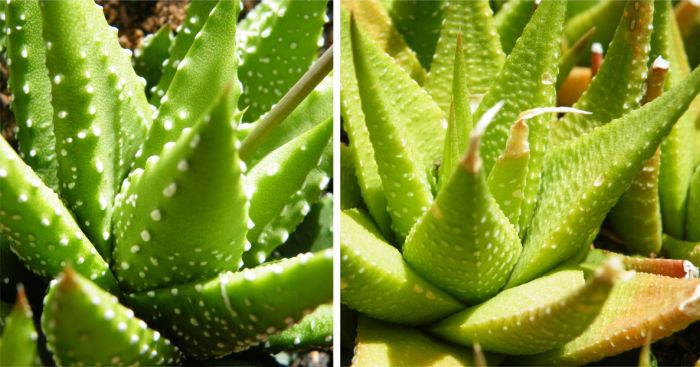
Fig. 2. A close-up of two different clones of the Enon haworthiopsis growing in containers.
Perianth tubular, curved, ascending-spreading, 14–18 mm long, white with purplish green midstripe. Capsule 12–14 × 3–4 mm. Seed 3 × 1–2 mm, greyish black, angular. Flowering time is mainly from spring to early summer (October–November). Seeds are dispersed by wind in summer and early autumn.

Fig. 3. The inflorescence and flowers of Haworthiopsis attenuata ‘Enon’, plants growing in a container.
Conservation Status
Status
Haworthia attenuata is assessed as Vulnerable (VU) by the Red List of South African plants website, because its wild population had declined by an estimated 30% in the past 100 years (2 generations) due to unsustainable harvesting for the trade in medicinal and horticultural plants, and loss of habitat. The subspecies have not yet been assessed. The Enon variety, although it is a local endemic confined to the Enon region near Kirkwood (Eastern Cape), it is well protected by its sheer cliff-face habitat, which makes the plants difficult to reach, and its distribution falls within a greater conservation region. Consequently, it is not threatened.
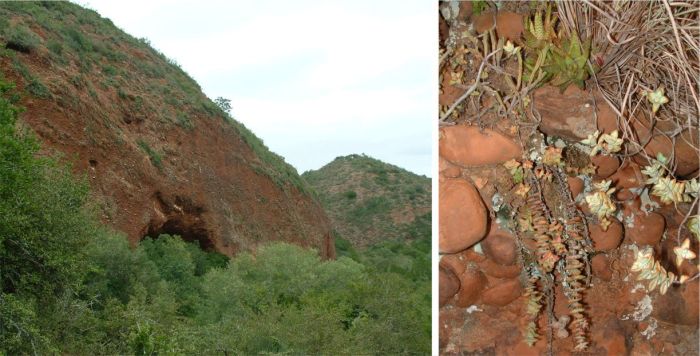
Fig. 4. The south-facing Enon Conglomerate cliff face near Kirkwood in the Eastern Cape, and two plants of Haworthiopsis attenuata ‘Enon’ growing on a ledge with other succulents Crassula lactea, C. muscosa, C. perforata and C. rupestris and Anacampseros lanceolata.
Distribution and habitat
Distribution description
This cremnophilous form of Haworthiopsis attenuata is confined to the Enon Conglomerate cliffs near the town of Enon in the Eastern Cape, along the Enon River, at an altitude of about 400 m. It grows on south-facing cliffs, the plants firmly rooted in crevices, their size often depending on the growing space allowed by the crevice. Temperature is high in summer (35–40°C). Winters are cooler but frost is absent. Rainfall occurs throughout the year but mostly in summer, ranging from 300–400 mm per annum (thunder showers or cyclonic winter rain).
The associated vegetation consists of Sundays Thicket of the Albany Thicket Biome (Mucina et al. 2005). The accompanying species growing with Haworthiopsis attenuata var attenuata ‘Enon’ include; Adromischus sphenophyllus, Anacampseros arachnoidea, Crassula cultrata, C. lactea and C. perforata.
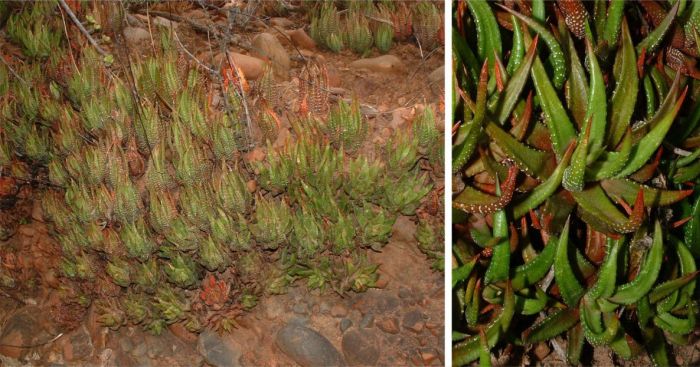
Fig. 5. A dense mat-forming group of the Enon haworthiopsis on a south-facing Enon Conglomerate cliff ledge at Enon near Kirkwood, and a close-up of plants in the group
Derivation of name and historical aspects
History
Haworthiopsis attenuata var attenuata was named by Adrian Haworth (1768-1833) as Aloe attenuata in Transactions of the Linnaean Society in 1804. Haworth, in an 1812 publication, transferred his species to Duval’s newly named genus Haworthia. The species name attenuata means ‘narrowing to a point’ and pertains to the shape of the leaves.
In fact it was the Frenchman H.A. Duval who honoured the British succulent expert, Adrian Haworth, by naming his new genus Haworthia in his work Plantae succulentae in Horto Alenconio, published in 1809. Haworthia became very popular among succulent enthusiasts and students, and many new species were discovered. Within the genus Haworthia, three distinct subgenera: Robustipedunculares, Hexangulares and Haworthia were named, and Gordon Rowley, who realised their distinctness, created two new genera: Haworthiopsis (subgenus Hexangulares) and Tulista (subgenus Robustipedunculares). This was later verified by molecular evidence garnered by John Manning and his colleagues in 2014.
This distinctive form of Haworthiopsis attenuata from Enon was discovered by the Haworthia expert, Bruce Bayer (former Curator of the Karoo National Botanical Garden) and his wife Daphne. They accompanied the author and a party from Kirstenbosch to the plants in habitat at Enon on 4 March 2003, while on an expedition near Kirkwood, when these habitat illustrations were taken.

Fig. 6. Haworthia expert and a former Curator of the Karoo National Botanical Garden (SANBI), Bruce Bayer, helping his wife Daphne down the Enon Conglomerate cliff.
Ecology
Ecology
The Enon Conglomerate cliff substrate is mineral-poor, giving rise to slightly acidic soil. The crevices and ledges, perhaps not as efficient as crevices and ledges on sandstone or dolomite, provide habitat for a few endemic cliff-dwellers, such as this obligatory cliff-dwelling Enon form of Haworthiopsis attentuata var. attenutata. The poor soil and harsh cliff habitat cause stress that results in plants that are adapted to this particular environment.
Haworthiopsis attenuata ‘Enon’ plants in habitat are very variable in leaf epidermis colour and shape. This genetic variability is the basis for adaptation and shows a healthy, genetically variable population. The plants vary in the tubercle size, shape and colour as well as general leaf shape.
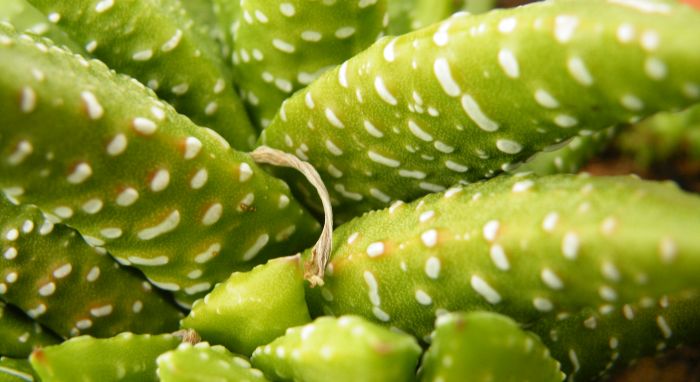
Fig. 7. A close-up of the leaf texture of an Enon haworthiopsis growing in a container.
The plants grow in conspicuous, compact, mat-forming to globose clusters. The succulent leaves provide sufficient moisture, enabling the plant to cope with regular dry periods. The leaf orientation is ascending to spreading becoming somewhat recurved to maximise absorption of light on the shady south-facing cliff. The green leaves become reddish during dry conditions, as a result of the pigment anthocyanin, reducing photosynthesis. The plants are also slow-growing and long-lived, with firm leaves withering from the base. The fleshy leaves becoming turgid after rain, and are channelled during dry periods, an adaptation to the dry habitat. The slow growth rate and long-lived leaves can be viewed as an adaptation to mineral-poor soil. The leaves of this Enon form of Haworthiopsis attenuata are more triangular and shorter, with a reduction in tubercles and often with a smooth surface, all adaptations to the shady, south-facing cliff environment.

Fig. 8. A dense mat-forming group of two clones of Haworthiopsis attenuata ‘Enon’ on a ledge on a south-facing Enon Conglomerate cliff at Enon near Kirkwood, Eastern Cape.
The inflorescence is ascending to spreading, the small, tubular, 2-lipped, white corolla attracting a pollinating flying insect. The seed is small and angular, ideal for establishment in crevices. The light seeds are shaken from the capsules and dispersed by wind. The seeds ripen in summer and autumn, coinciding with the rainy season. Germination occurs after about 14–21 days.
Haworthiopsis attenuata ‘Enon’ is very prolific and suckers freely from the base, forming dense clusters. The different clones on the cliff face are easily distinguishable. Continual sprouting from the base represents an efficient vegetative backup dispersal strategy for this harsh cliff-face environment.
Uses
Use
Haworthiopsis attenuata is a popular plant in horticulture and in traditional medicine, where it is used to treat stomach troubles and as sprinkling charms against mischief and cultivated on roofs as a protective charm against lightning, but the Enon variety is not known to be used because it grows in an inaccessible habitat.
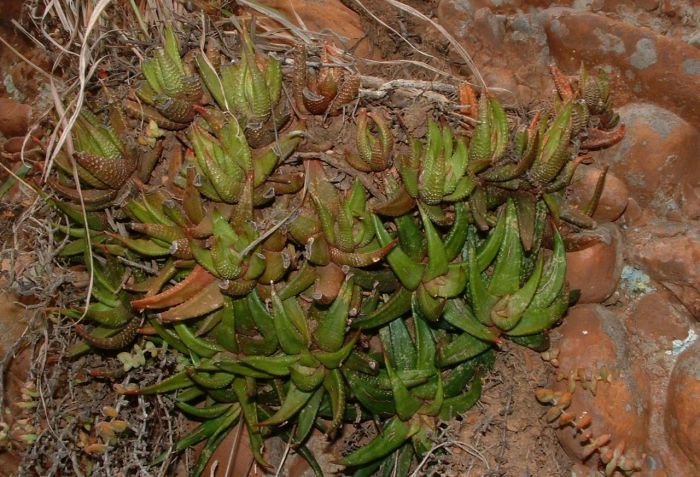
Fig. 9. A dense mat-forming group containing two clones of the Enon haworthiopsis on a ledge of the south-facing Enon Conglomerate cliff at Enon near Kirkwood.
Growing Haworthiopis attenuata var. attenuata ‘Enon’
Grow
Haworthiopsis attenuata var. attenuata ‘Enon’ is a decorative, easily grown plant. It is easily propagated from division or seed. Generally the shelf life of seed within the Asphodelaceae is not long, and seed should preferably be sown within a year of gathering.
It is best grown as a pot plant in partial shade and kept in small containers, simulating the small crevices of the cliff environment. The soil should be sandy and slightly acidic, with ample feeding throughout the year. Outside its habitat, in Mediterranean-type climates where frost is not severe, it can also be grown on a rockery in shallow soil. In colder climates the plants should be kept indoors during winter.
In its habitat at Enon, near Kirkwood in the Eastern Cape, rain can be expected at any time of the year but more so from spring to autumn. In cultivation it is best to water well in summer and keep dry in winter. The young plants start solitary, but soon divide to form small, dense clusters. It is a slow grower. It is best to divide clumps in winter, but it can also be done at any time of the year. They will react to any fertiliser, but organic fertilisers, such as well broken down compost, are best.
Sow seed in spring, summer or autumn, in a sandy medium. First moisten the substrate with fine rose. Cover the seed lightly with a thin layer of sand. Keep moist and in a shady position. Germination is usually within 3 weeks and the young seedlings relatively fast growing. Transplant seedlings to individual containers once large enough to handle.
Plants are relatively disease free but aphids, slugs and snails can sometimes be a problem.
References
- Bayer, M.B. 1999. Haworthia revisited, a revision of the genus. Umdaus Press, Hatfield.
- Duval, H.A. 1809. Plantae succulentae, in Horto Alenconio. Paris.
- Haworth, A. H. 1804. A new arrangement of the genus Aloe. Transactions of the Linnaean Society 7: 11.
- Haworth, A. H. 1812. Synopsis Plantarum Succulentarum. London.
- Haworth, A.H. 1826. Description of new succulent plants. Philosophical Magazine 57: 92.
- Hutchings, A., Scott, A.H., Lewis, G. & Cunningham, A.B. 1996. Zulu medicinal plants: an inventory. University of Natal Press, Pietermaritzburg.
- Manning, J.C. et al. 2014. A molecular phylogeny and generic classification of Asphodelaceae subfamily Alooideae: A final resolution of the prickly issue of polyphyly in the alooids? Systematic Botany 39: 55–74. http://dx.doi.org/10.1600/036364414X678044
- Mucina, L. & Rutherford, M.C. (eds) 2006. The vegetation of South Africa, Lesotho and Swaziland. Strelitzia 19. South African National Biodiversity Institute, Pretoria.
- Rowley, G.D. 2013. Generic concepts in Alooideae: Part 3 – The phylogenetic story. Alsterworthia International Special Issue 10: 3–6.
- Scott, C.L. 1985. The genus Haworthia, a taxonomic revision. Aloe Books, Johannesburg.
- Williams, V.L., Manyama, P.A., Helme, N.A., Kamundi, D.A., Dold, A.P. & von Staden, L. 2014. Haworthiopsis attenuata (Haw.) G.D.Rowley. National Assessment: Red List of South African Plants version 2020.1. Accessed on 2021/07/15
Credits
Ernst van Jaarsveld
Kirstenbosch National Botanical Garden (Retired 2015)
Babylonstoren Farm
Extraordinary senior lecturer and researcher,
Department of Biodiversity and Conservation, University of the Western Cape
June 2021
Plant Attributes:
Plant Type: Succulent
SA Distribution: Eastern Cape
Soil type: Sandy
Flowering season: Spring, Early Summer
PH: Acid
Flower colour: Green, White
Aspect: Shade, Morning Sun (Semi Shade), Afternoon Sun (Semi Shade)
Gardening skill: Easy
Special Features:
Horticultural zones








Rate this article
Article well written and informative
Rate this plant
Is this an interesting plant?
Login to add your Comment
Back to topNot registered yet? Click here to register.